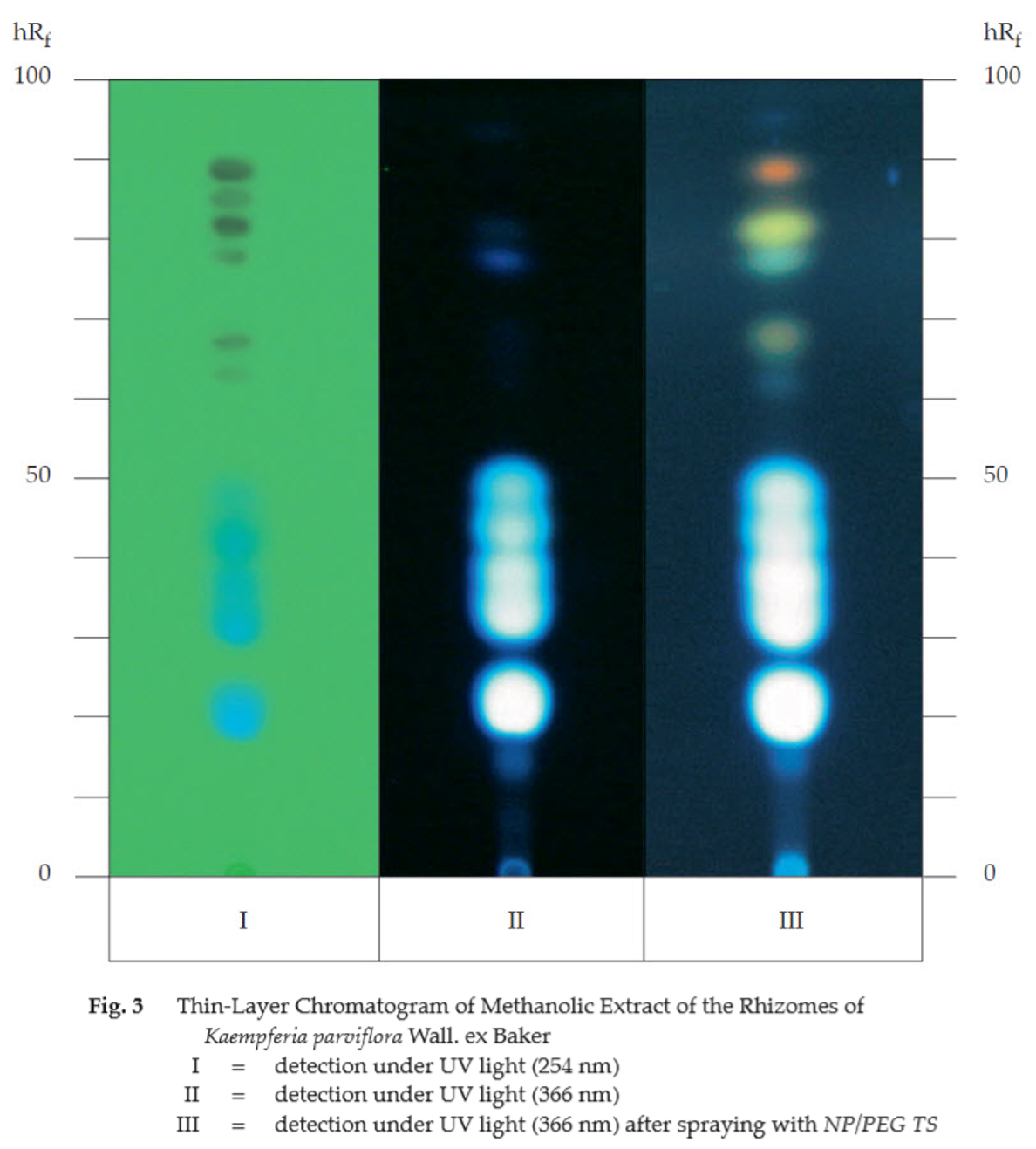ตำรามาตรฐานยาสมุนไพรไทย
Thai Herbal Pharmacopoeia
สำนักยาและวัตถุเสพติด กรมวิทยาศาสตร์การแพทย์ กระทรวงสาธารณสุข
Bureau of Drug and Narcotic, Department of Medical Sciences, Ministry of Public Health(Tinospora crispa (L.) Hook.f. & Thomson)
(Nelumbo nucifera Gaertn.)
(Centella asiatica (L.) Urb.)
(Centella Dry Extract)
(Centella Cream)
(Mesua ferrea L.)
(Piper sarmentosum Roxb.)
(Piper sarmentosum Roxb.)
(Pterocarpus santalinus L. f.)
(Santalum album L.)
(Senna tora (L.) Roxb.)
(Senna alata (L.) Roxb.)
(Senna Alata Tea)
(Piper retrofractum Vahl)
(Myristica fragrans Houtt)
(Andrographis paniculata (Burm. f.) Nees)
(Andrographis Capsules)
(Allium ascalonicum L.)
(Ocimum tenuiflorum L.)
(Curcuma longa L.)
(Turmeric Capsules)
(Turmeric Dry Extract)
(Turmeric Dry Extract Capsules)
(Arcangelisia flava (L.) Merr.)
(Curcuma sp.)
Harrisonia perforata (Blanco) Merr.
(Aristolochia pierrei Lecomte)
(Zingiber officinale Roscoe)
(Ginger Capsules)
(Ginger Tea)
(Cassia fistula L.)
(Nardostachys jatamansi (D. Don) DC.)
(Angelica sinensis (Oliv.) Diels)
Artemisia annua L.
(Ligusticum sinense Oliv. cv. Chuanxiong)
(Neopicrorhiza scrophulariiflora Pennell)
(Atractylodes lancea (Thunb.) DC.)
(Aucklandia lappa Decne)
(Terminalia chebula Retz.)
(Angelica dahurica (Hoffm.) Benth. & Hook. f. ex Franch. & Sav. var. dahurica)
(Kaempferia parviflora Wall. ex Baker)
(Hibiscus sabdariffa L.)
(Roselle Tea)
(Allium sativum L.)
(Zingiber zerumbet (L.) Sm.)
(Wurfbainia testacea (Ridl.) Škorničk.& A. D. Poulsen)
(Cannabis sativa L.)
(Myristica fragrans Houtt)
(Dracaena cochinchinensis (Lour.) S. C. Chen)
(Ficus racemosa L.)
(Hyptis suaveolens (L.) Poit.)
Clerodendrum indicum (L.) Kuntze
(Phyllanthus emblica L.)
(Citrus hystrix DC.)
(Citrus hystrix DC.)
(Areca catechu L.)
(Momordica charantia L.)
Moringa oleifera Lam.
(Aegle marmelos (L.) Corrêa)
(Solanum trilobatum L.)
(Morus alba L.)
Gynostemma pentaphyllum(Thunb.)
Makino
(Clinacanthus nutans (Burm. f.) Lindau)
(Cissus quadrangularis L.)
(Mimusops elengi L.)
(Zingiber montanum (J. König) Link. ex A. Dietr.)
(Piper betle L.)
(Capsicum annuum L.)
(Capsicum Oleoresin)
(Capsicum Gel)
(Piper nigrum L.)
(Piper nigrum L.)
(Eurycoma longifolia Jack)
(Thunbergia laurifolia Lindl.)
(Piper wallichii (Miq.) Hand.-Mazz.)
Senna garrettiana (Craib) H. S. Irwin & Barneby
(Terminalia bellirica (Gaertn.) Roxb.)
(Terminalia chebula Retz.)
(Caesalpinia bonduc (L.) H. Roxb.)
(Tarlmounia elliptica (DC.) H. Rob., S. C. Keeley, Skvaria & R. Chan)
(Hog Creeper Vine Dry Extract Capsiles)
(Hog Creeper Vine Dry Extract)
(Brachypterum scandens (Roxb.) Miq.)
(Lepidium sativum L.)
(Nigella sativa L.)
(Cuminum cyminum L.)
(Foeniculum vulgare Mill.)
(Plantago ovata Forssk.)
(Pimpinella anisum L.)
(Carum carvi L.)
(Anethum graveolens L.)
(Trachyspermum ammi (L.) Sprague)
Albizia procera (Roxb.) Benth.
(Acorus calamus L.)
(Tiliacora triandra (Colebr.) Diels)
Cyanthillium cinereum (L.) H. Rob.
(Orthosiphon aristatus (Blume) Miq.)
Murdannia loriformis (Hassk.) R. S. Rao & Kammathy
(Capparis micracantha DC.)
(Chrysopogon zizanioides (L.) Roberty)
(Cyperus rotundus L.)
(Cannabis sativa L.)
(Syzygium aromaticum (L.) Merr. & L. M. Perry)
(Boesenbergia rotunda (L.) Mansf.)
(Acanthus ebracteatus Vahl)
(Acanthus ilicifolius L.)
(Kaempferia galanga L.)
(Curcuma comosa Roxb.)
Betula alnoides Buch.-Ham. ex D. Don
Cannabis sativa L.
Carthamus tinctorius L
Mitragyna speciosa (Korth.) Havil
Mallotus repandus (Rottler) Müll. Arg
Azadirachta indica A. Juss. var. siamensis Valeton
Azadirachta indica A. Juss. var. siamensis Valeton
Punica granatum L.
Rhinacanthus nasutus (L.) Kurz
Baliospermum solanifolium (Burm.) Suresh
Curcuma aeruginosa Roxb
Boesenbergia kingii Mood & L. M. Prince
Senegalia rugata (Lam.) Britton & Rose
Acacia concinna (Willd.) DC.
Senegalia rugata (Lam.) Britton & Rose
Acacia concinna (Willd.) DC.
Senna alexandriana Mill. var. alexandriana
Cassia acutifolia Delile, Cassia angustifolia Vahl
Butea superba Roxb. ex Willd.
[Plaso superba (Roxb. ex Willd.) Kuntze, Rudolphia superba (Roxb. ex Willd.) Poir.
Pueraria candollei Graham
ex Benth. var. mirifica (Airy Shaw & Suvat.) Niyomdham
Streblus asper Lour.
Suregada multiflora (A. Juss.) Baill. (Gelonium
multiflorum A. Juss.
Kaempferia Parviflora Rhizome is the dried rhizome of Kaempferia parviflora Wall. ex Baker [K. rubromarginata (S. Q. Tong) R. J. Searle, Stahlianthus rubromarginatus S. Q. Tong] (Family Zingiberaceae), Herbarium Specimen Number: DMSC 1575, Crude Drug Number: DMSc 548.
Constituents Kaempferia Parviflora Rhizome contains volatile oil, of which borneol is major component. It also contains flavonoids, anthocyanins, etc.
Description of the plant (Figs. 1a, 1b) Herb up to 25 cm tall; rhizome, subglobose to globose, light to dark purple within, with several succulent roots in a fascicle. Leaves one to several; blades ovate or elliptic, slightly unequal sided, 7 to 20 cm long, 4 to 9 cm wide, apex acute or mucronate, base subcordate, upper surface glabrous, under surface hairy; leaf-sheaths 6 to 12 cm long, margin membranous, green or with red-tinted; bladeless sheaths greenish, purple-tinted or purple; ligule broadly triangular, about 2 mm long, membranous, caducous. Inflorescence enclosed by two innermos t leaf-sheaths or leaf-sheath and the bladeless sheath, usually elongate; peduncle 5 to 6 cm long; bract oblong, 1.7 to 2.3 cm long, about 6 mm wide, glabrous, apex rounded; bracteole linear, 6 to 12 mm long, 1 to 2 mm wide, glabrous, apex rounded. Flowers many, up to 20; calyx 1.8 to 2.2 cm long, finely hairy, apex bifid; corolla tube about 3 cm long, lobes linear; dorsal lobe about 1.2 cm long, about 3 mm wide, apex hooded, aris tate, lateral lobes slightly smaller, apex rounded; staminode white, oblong, 1 to 1.3 cm long, about 3 mm wide, apex acute or rounded. Labellum, white to light purple, darker at the base, obovate, 1.2 to 1.5 cm long, 8 to 9 mm wide, apex emarginate; stamen with very short filament, about 1 mm long, anther about 2 mm long, anther crest suborbicular, entire or emarginate, 1 to 1.5 mm long, about 2 mm wide; ovary about 2 mm long, about 1 mm wide, hairy; stylode filiform, about 5 mm long.
Description Odour, characteristic and aromatic; taste, slightly bitter.
Macroscopical (Fig. 1a) Subglobose to globose horizontally continuous rhizomes, sometimes with roots and rootlets; outer surface slightly wrinkled, brown to dark brown, with scars of pseudostems; fracture light to dark purple, mealy. Some occur as transverse slices, varying in shape and size.
Microscopical (Figs. 2a, 2b) Transverse section of the rhizome shows several layers of corky parenchyma cells. Cortex, broad zone of parenchyma cells, filled with numerous simple starch grains and purple anthocyanins, some of which containing yellowish oleoresins with small particles. Pseudoendodermis, layers of thin-walled rectangular cells. Vascular bundles, scattered; fibres, non-lignified; vessels, spiral, scalariform and reticulate, non-lignified.
Kaempferia Parviflora Rhizome in powder possesses the diagnostic microscopical characters of the unground drug.
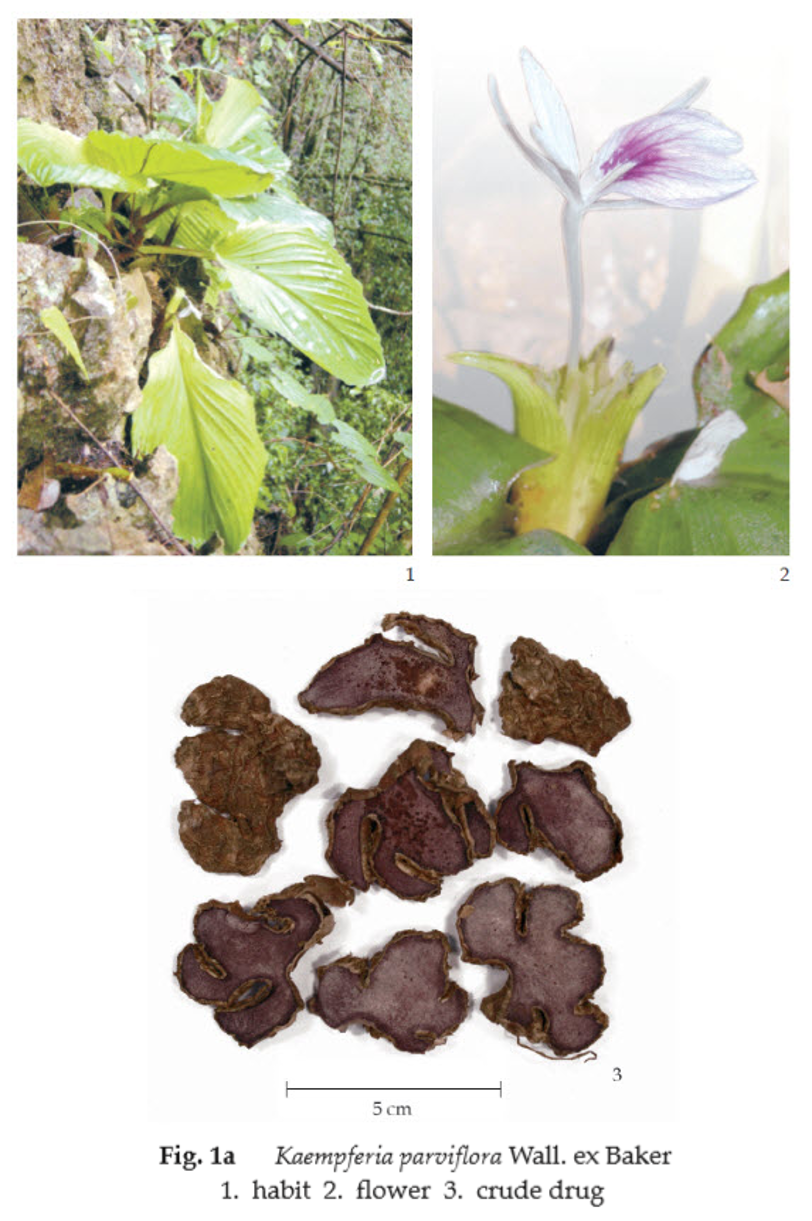
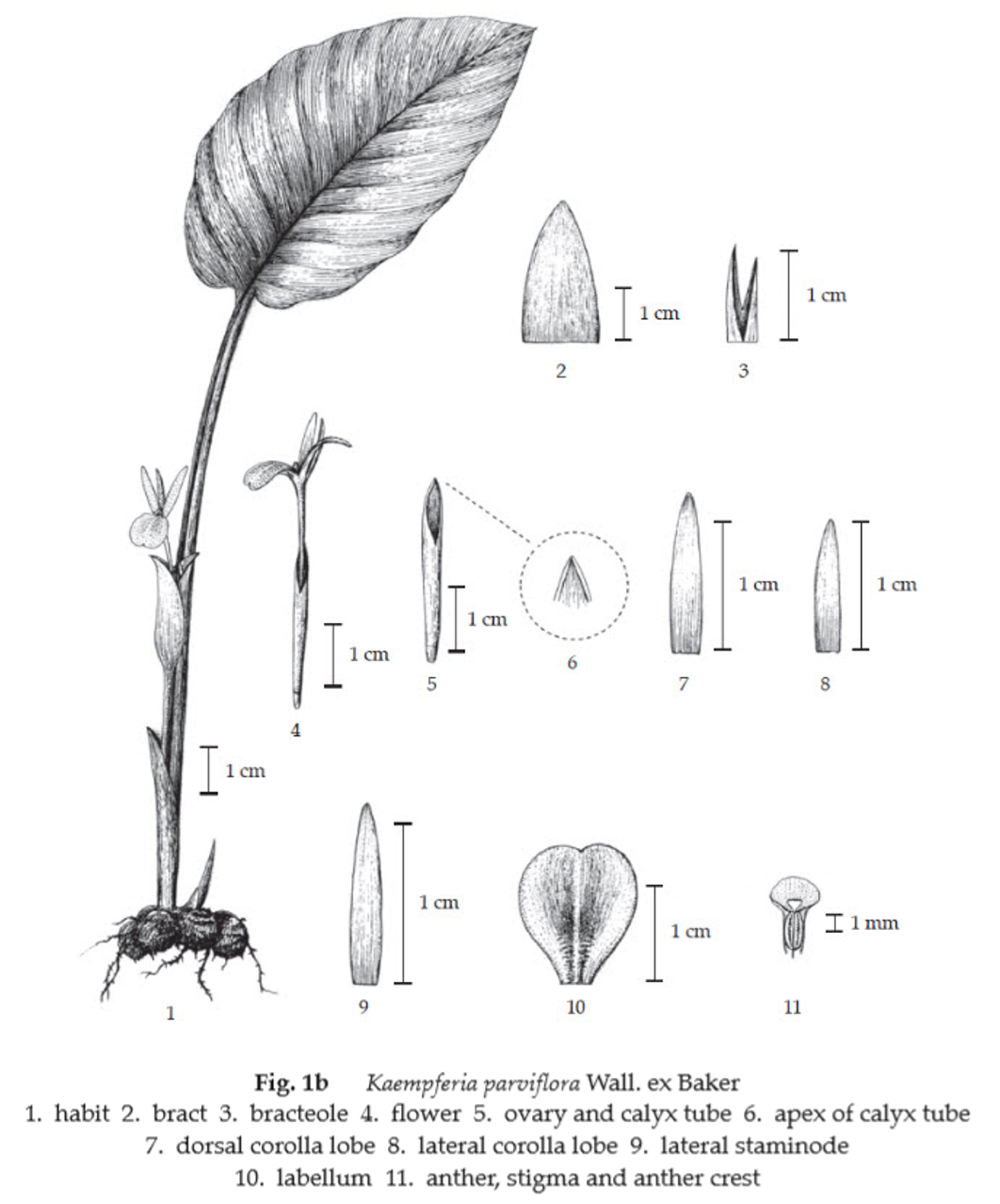
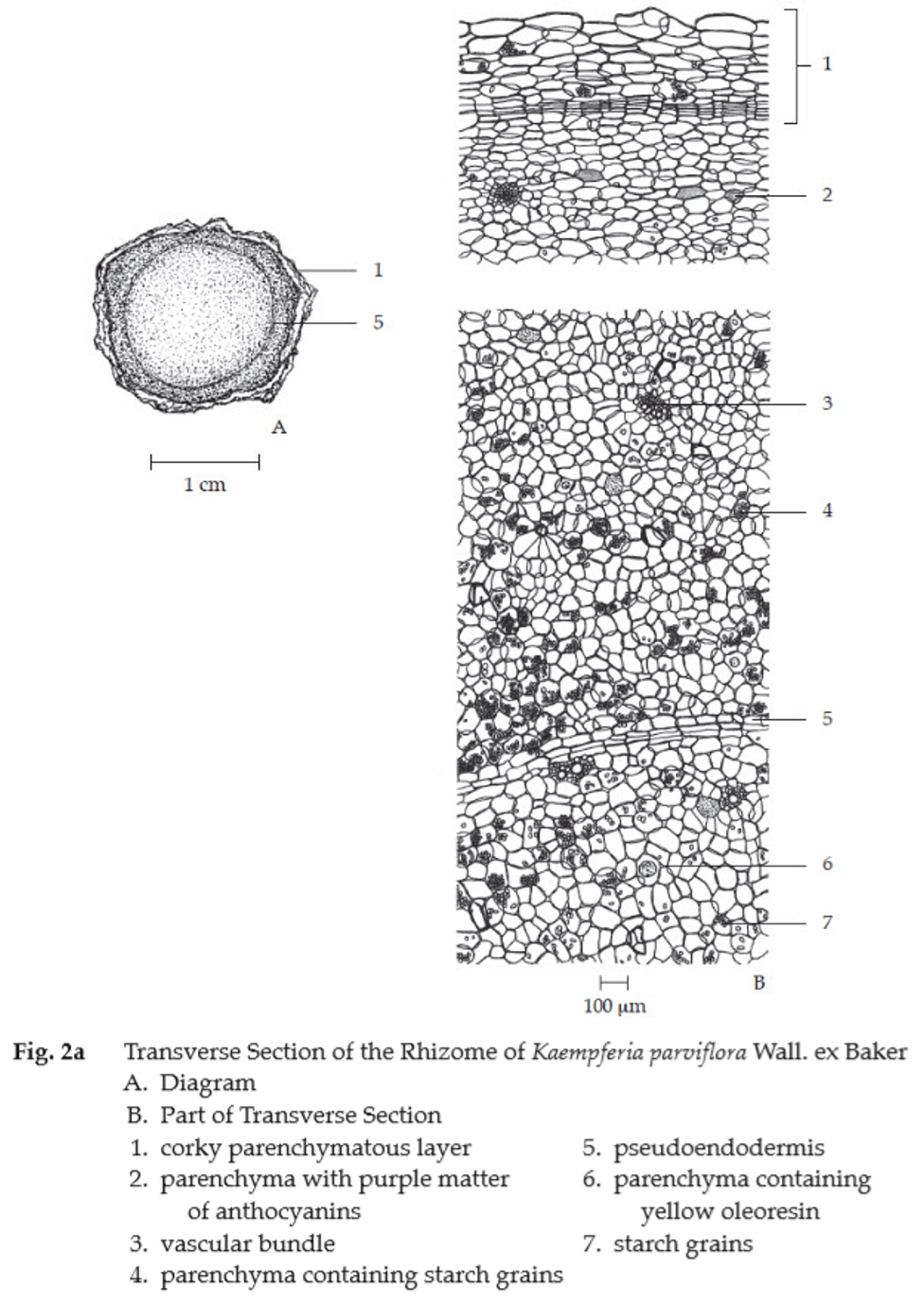
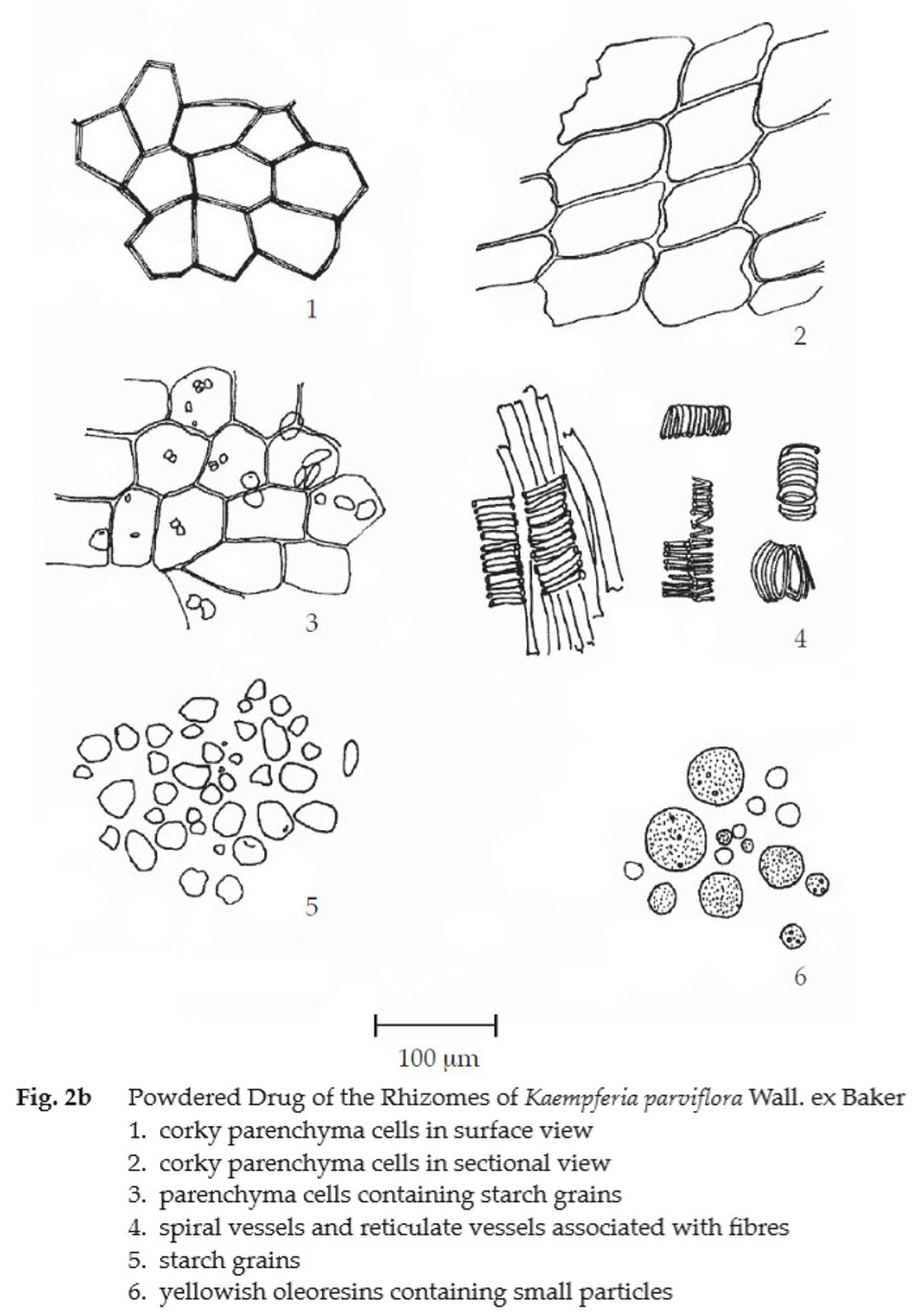
Packaging and storage Kaempferia Parviflora Rhizome shall be kept in well-closed containers, protected from light, and stored in a dry place.
Identification
A. Reflux 1 g of the sample, in fine powder, with 20 mL of ethanol for 5 minutes and filter (solution 1). To 5 mL of solution 1, add 1 g of decolorizing charcoal, mix and filter. Add 2 drops of a freshly prepared 1 per cent w/v solution of vanillin in ethanolic sulfuric acid, mix well and heat in a water-bath for 2 minutes: a blue colour is produced.
B. To 2 mL of solution 1, add 1 drop of a 5 per cent w/v solution of potassium hydroxide: a green to blue colour is produced and changed to red after adding 1 drop of a 20 per cent v/v solution of sulfuric acid.
C. Apply 2 drops of solution 1 to a filter paper and air-dry. Add to the same spot, 1 drop of ethanolic ninhydrin TS and dry in a current of hot air: a violet colour develops
D. To 2 mL of solution 1, add 1 piece of magnesium ribbon, shake well and mix with 2 drops of hydrochloric acid: a red colour develops.
E. Carry out the test as described in the “Thin-Layer Chromatography” (Appendix 3.1), using silica gel GF254 as the coating substance and a mixture of 60 volumes of n-hexane, 30 volumes of ethyl acetate and 5 volumes of formic acid as the mobile phase and allowing the solvent front to ascend 10 cm above the line of application. Apply to the plate, 5 μL of the test solution prepared by refluxing 500 mg of the sample, in fine powder, with 10 mL of methanol for 5 minutes and filtering. Dilute the filtrate with methanol to 10 mL. After removal of the plate, allow it to dry in air and examine under ultraviolet light (254 nm), marking the quenching spots. Several blue spots also appear. Examine the plate under ultraviolet light (366 nm) through the cut-off filter, five blue fluorescent spots of different hRf values are observed. Heat the plate at 80° for 10 minutes and then spray with natural products (NP) TS while the plate is still warm. Subsequently spray the plate with polyethyleneglycol (PEG) TS and observe the colours of the spots under ultraviolet light (366 nm) through the cut-off filter within 5 to 15 minutes. Several fluorescent spots of different colours appear (Table 1); see also Fig. 3.
Table 1 hRf Values of Components in Methanolic Extract of the Rhizomes of Kaempferia parviflora Wall. ex Baker
| Spot | hRf Value | Detection | ||
| UV 254 | UV 366 | UV 366 after spraying with NP/PEG TS |
||
| 1 2 3 4 5 6 7 8 9 10 |
17-26 29-35 36-40 41-46 46-52 64-69 74-78 78-82 83-86 87-90 |
blue blue blue blue blue weak quenching weak quenching weak quenching weak quenching weak quenching |
blue blue blue blue blue - - - - - |
blue blue blue blue blue yellow yellow-green yellow yellow orange |
Water Not more than 10.0 per cent v/w (Azeotropic Distillation Method, Appendix 4.12).
Foreign matter Not more than 2.0 per cent w/w (Appendix 7.2).
Acid-insoluble ash Not more than 2.0 per cent w/w (Appendix 7.6).
Total ash Not more than 6.0 per cent w/w (Appendix 7.7).
Ethanol-soluble extractive Not less than 8.0 per cent w/w (Appendix 7.12).
Water-soluble extractive Not less than 17.0 per cent w/w (Appendix 7.12).
